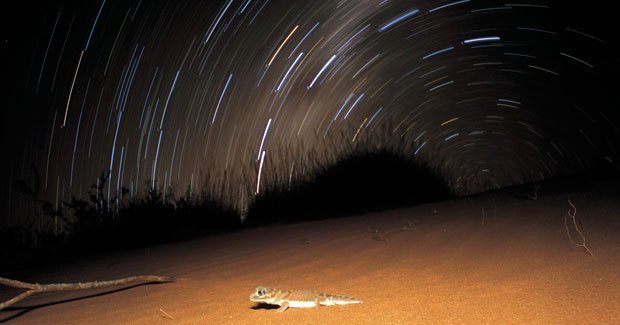Aboriginal astronomers: world’s oldest?

THERE’S GROWING EVIDENCE THAT Australia’s indigenous people could be the world’s oldest astronomers, according to astrophysicist Ray Norris, who is based at CSIRO’s Australia Telescope National Facility in Sydney.
He has researched Aboriginal stories about the night sky for five years and says one of the earliest European records of indigenous astronomy was made by William Stanbridge, an Englishman who emigrated to Australia in 1841 and ran sheep at Lake Tyrrell, in northern Victoria. Stanbridge befriended members of the local Boorong people. They showed him how they viewed the constellations and Stanbridge published their stories in his 1857 essay On the Astronomy and Mythology of the Aborigines of Victoria.
Stanbridge’s writings recorded the Boorong’s holistic use of astronomy and explained how they integrated their understanding of the stars with knowledge of the land and seasons, Ray says. For example, the constellation western astronomers know as Lyra forms the base of what the Boorong called Neilloan – a malleefowl, whose outline in the night sky heralded the bird’s egg-laying period, as it appears in the southern hemisphere between March and October, coinciding with its mound-building season.
He believes astronomy can, like music and the arts, build a strong bridge of understanding between indigenous and non-indigenous Australians. Ray explains that different Aboriginal groups have varying interpretations of southern sky constellations. But there are broad similarities between many, such as the Coalsack Nebula (the emu in the sky).
DEPENDING ON THE CONTEXT, many Aboriginal groups also have different stories for the same constellations. Bill Yidumduma Harney, an elder of the Wardaman south-west of Katherine, in the Northern Territory, says his people, for example, use many different constellations for a variety of purposes. The Wardaman also use traditional cosmology to tell them about the land, the seasons – even time. “When you’re travelling it will tell you where to go. You can tell by the stars what time it is without a watch,” says Bill, who co-authored Dark Sparklers, a book on the subject.
Stephen Gilchrist, indigenous art curator at Melbourne’s National Gallery of Victoria, is spreading the message. He recently mounted an exhibition called Shared Sky featuring works by artists depicting Australia’s night sky. “Aboriginal ancestral narratives aren’t just about the land – they’re also about the Sun, the Moon and the stars,” Stephen, from Western Australia’s Inggarda language group, explains. “Indigenous people have a very holistic understanding of the universe. It doesn’t just stop at the horizon.”
Arnhem Land’s Yolngu people have ancestral narratives about tides, eclipses, the rising and setting of the Sun, Moon and planets. Stephen says there is a new fascination with the way Australia’s first people apply knowledge about the sky and land. Indigenous cosmic understanding can go hand in hand with established European interpretations, he says.
Perspectives of the southern cross
This distinctive constellation is widely viewed as a significant symbol by indigenous groups.
> To Victoria’s Kulin Nation people, based around Melbourne, the Southern Cross represents Bundjil, a sky god in the form of an eagle.
> For the Anindilyakwa of Groote Eylandt, in the Gulf of Carpentaria, the Southern Cross is two fishermen and their cooking fires.
> Coastal SA’s Ngarrindjeri people see the Southern Cross as a stingray chased by two sharks – the two pointers adjacent the cross. The shark is a sacred Ngarrindjeri totem.
> The Boorong people – a group that no longer exists but has descendents in Victoria – saw the Southern Cross as ringtail possum Bunya hiding in a tree from the wicked emu Tchingal whose silhouette could be seen in the Coalsack Nebula.
> The Arrernte people of Central Australia see the Southern Cross as the wedge-tailed eagle Waluwara. The four brightest stars make up his talons; the Coalsack Nebula his nest.
Source: Australian Geographic Issue 97 (Jan – Mar 2010)

